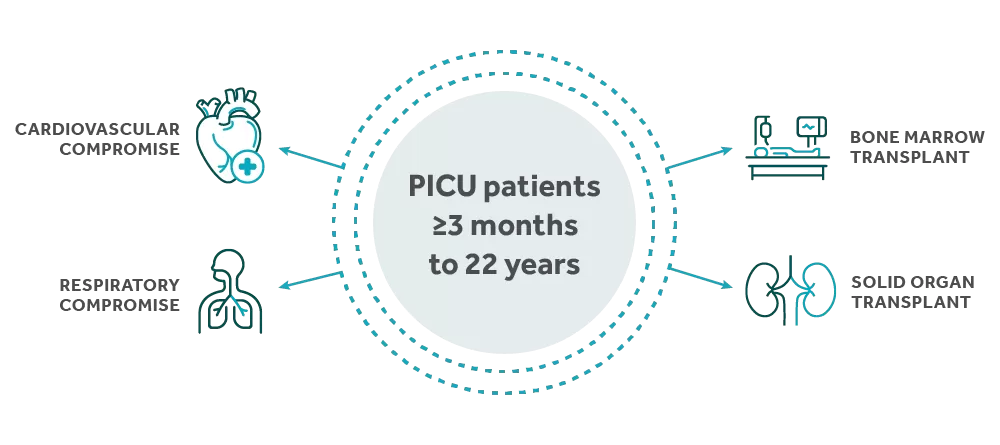Acute Kidney Injury
Common in hospitalized patients, increasing in incidence, and associated with adverse outcomes. But, hard to identify.
AKI Risk Factors
Acute kidney injury (AKI) is a rapid loss of kidney function, which typically happens as a complication of another serious illness or intervention. Because pain and other symptoms don’t usually occur, rapid identification of patients who are at riski is critical, as there is no specific treatment for AKI.
Identify risk of pediatric AKI with ProNephro AKI (NGAL).

Pediatric AKI is Common and Costly
1 in 4
Critically ill children at riskii
+11 Days
Stays in the PICUiii
2x
Risk of CKD diagnosisv
AKI Classification Systems
The definition of AKI, previously known as acute renal failure (ARF), has evolved for nearly two decades, as clinicians have struggled to classify the condition.vi
Developed in 2012, the current KDIGO definition and staging of AKIvii are summarized here. These guidelines are under review with updates expected in 2025.
KDIGO - Kidney Disease Improving Global Outcomes Criteria
| Stage | Serum Creatinine | Urine Output |
|---|---|---|
| 1 | 1.5–1.9 times baseline,or ≥0.3 mg/dL >26.5 μmol/L increase | <0.5 mL/kg/h for 6-12h |
| 2 | 2–2.9 times baseline | <0.5 mL/kg/h for ≥12h |
| 3 | 3 times baseline, OR Increase in serum creatinine to ≥4 mg/dL, OR Initiation of renal replacement therapy | <0.3 mL/kg/h for ≥24h, or anuria for ≥12h |
Receive AKI Guideline Updates
Stay up to date on the latest kidney care guideline updates. We’ll issue them as they become available.
AKI Assessment Using Functional and Damage Biomarkers
In 2020, the Acute Disease Quality Initiative (ADQI) workgroup recommended that “a combination of damage and functional biomarkers, along with clinical information, be used to improve the diagnostic accuracy of AKI, to recognize the different pathophysiological processes, to discriminate AKI etiology, and to assess AKI severity.”viii
Neutrophil gelatinase-associated lipocalin (NGAL) is a renal damage biomarker with extensive research in different patient populations and clinical settings.

iFuhrman DY, Stanski NL, Krawczeski CD, Greenberg JH, Arikan AAA, Basu RK, Goldstein SL, Gist KM; ADQI 26 workgroup. A proposed framework for advancing acute kidney injury risk stratification and diagnosis in children: a report from the 26th Acute Disease Quality Initiative (ADQI) conference. Pediatr Nephrol. 2024 Mar;39(3):929-939.
iiKaddourah A, Basu R, Bagshaw SM, Goldstein SL for the AWARE Investigators. Epidemiology of acute kidney injury in critically ill children and young adults. N Engl J Med 2017;376:11-20
iiiKeshwah S, Hashmat S, Mahavad V. Underreported acute kidney injury in pediatric critical care: incidence, risk factors, and outcomes. Critical Care Medicine. 2020;48(1)694.
ivSutherland SM, Ji J, Sheikhi FH, Widen E, Tian L, Alexander SR, Ling XB. AKI in hospitalized children: epidemiology and clinical associations in a national cohort. Clin J Am Soc Nephrol. 2013 Oct;8(10):1661-9.
vHessey E, Perreault S, Dorais M, Roy L, Zappitelli M. Acute Kidney Injury in Critically Ill Children and Subsequent Chronic Kidney Disease. Can J Kidney Health Dis. 2019;6:2054358119880188.
viKellum JA, Levin N, Bouman C, Lameire N. Developing a consensus classification system for acute renal failure. Curr Opin Crit Care. 2002;8(6):509-514.
viiKhwaja A. KDIGO clinical practice guidelines for acute kidney injury. Nephron Clin Pract. 2012;120(4):c179-c184.
viiiOstermann M, Zarbock A, Goldstein S, et al. Recommendations on Acute Kidney Injury Biomarkers From the Acute Disease Quality Initiative Consensus Conference: A Consensus Statement JAMA Netw Open. 2020;3(10):e2019209.
